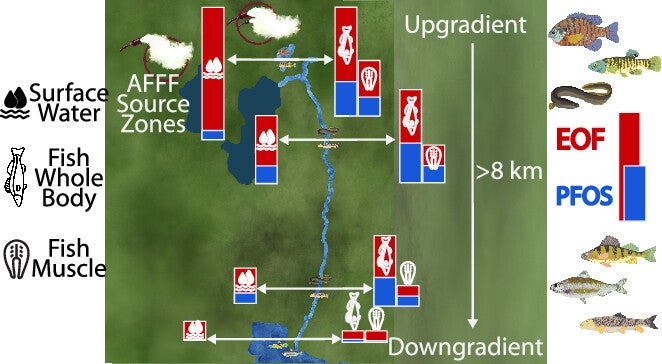Former STEEP trainee Heidi Pickard, PhD, knows a thing or two about PFAS on Cape Cod. In her latest publication in Environmental Science & Technology, Pickard partnered with STEEP scientists, STEEP alumni, and state and federal scientists to continue the study impacts from the use of aqueous fire fighting foams (AFFF) on Joint Base Cape Cod.
This area has been extensively studied by STEEP scientists in the past, producing a wealth of knowledge that has pushed our understanding of PFAS to new bounds. In this research, Pickard and colleagues analyzed fish downstream in surface waters to evaluate how far the fire fighting foam signature, AFFF, could travel and be detected in fish tissue.
In environmental studies such as these, scientists often employ statistical analysis tools that allow them to identify unique sources of PFAS that impact water, sediment, or in this case, fish. These signatures are a bit like clues that a detective would follow to retrace a crime scene. Here, STEEP scientists tried to do the very same thing, looking at the different mixture of PFAS that were detected in fish downstream to see if the PFAS in their tissue could have originated from AFFF.
Pickard’s study found that they could detect AFFF-derived PFAS in fish as far away as 8 kilometers, just about 5 miles downstream. Additionally, a very specific group of PFAS compounds, tightly associated with AFFF use, made up more than half of all PFAS found in fish. These compounds are called “precursors”, meaning they can break down into other PFAS. While it may seem counterintuitive for a “forever chemical” to break down, it is important to note that some PFAS, these precursors, do in fact transform. Unfortunately, they transform into other PFAS, stable and harmful compounds such as perfluorooctane sulfonate (PFOS), which is currently regulated at the federal level.
While this study demonstrates that AFFF is a major source of PFAS to fish in this region of Cape Cod, research also highlighted myriad PFAS sources in the area. Detected compounds suggested septic systems and agriculture could also be watershed sources of PFAS. Different sources compounding in one location underscores the importance of statistics to “trace” PFAS to a likely source. As we develop a better understanding of PFAS transport in the environment, studies further exemplify the need for a wide range of scientific strategies.
Heidi M. Pickard, Bridger J. Ruyle, Faiz Haque, John M. Logan, Denis R. LeBlanc, Simon Vojta, and Elsie M. Sunderland. Characterizing the Areal Extent of PFAS Contamination in Fish Species Downgradient of AFFF Source Zones. Environmental Science & Technology 2024 58 (43), 19440-19453.


